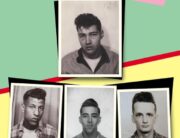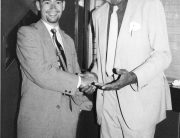 Having joined the ranks of the Rockabilly Radio DJs some 6 months ago, I was interested to find out a bit more about a station that’s been around since internet radio first became a ‘thing’. Fortunately, Marketing Manager and fellow DJ Julie Miranda (aka DJ Miss Aloha) was on hand to fill in the backstory and bring me up to date on the station’s history and the role it aims to achieve.
Having joined the ranks of the Rockabilly Radio DJs some 6 months ago, I was interested to find out a bit more about a station that’s been around since internet radio first became a ‘thing’. Fortunately, Marketing Manager and fellow DJ Julie Miranda (aka DJ Miss Aloha) was on hand to fill in the backstory and bring me up to date on the station’s history and the role it aims to achieve.
Rockabilly Radio is the brainchild of Don Freeman who started the station in the US in 2001 as a not-for-profit venture to give the exposure to new artists that mainstream broadcasting just wasn’t providing and to promote ‘real’ rockabilly in a musical landscape where it fell between ‘rock’ at one end of the scale and another swing revival at the other. In 2002, he enlisted the support of veteran UK DJ and promoter, Dave Brighton, who’d also been part of the team behind the Complete UK Rock’n’Roll Gig Guide, partly to make use of Dave’s technical know-how, but also to expand the roster of British DJs and spread word of the station on this side of the Atlantic. By 2004, Dave was managing scheduling and the appointment of new DJs, giving him the opportunity to broaden the genres played on the Rockabilly Radio airwaves beyond ‘pure’ rockabilly to encompass the full spectrum of rockin’ music, including rhythm and blues, hillbilly bop, and western swing – all while still providing a platform for new bands.
2010 brought a watershed, as Don’s failing health led him to hand the station over to Dave’s management in its entirety. On Don’s death in 2011, his family – recognizing the importance of Don’s musical legacy but lacking the technical skills to pick up the reins – decided that Dave’s position should become permanent and, by July 2011, Rockabilly Radio was back up and running, now with its headquarters (in other words, Dave’s place) in the UK. A period of consolidation and growth followed, including a number of years with Tom Ingram and Laura and Dean Weatherley on the management team. When they moved on to set up the Rockin’ 247 station, Dave brought on board the rest of the current management team, both DJs and experienced events organisers, with Julie (Hula Boogie) taking the lead on advertising and marketing, building partnerships with well-known brands like Vivian of Holloway, Vintage Rock magazine and, of course, the mighty Now Dig This. At the same time, Jezebel Straub (Spiders Web Club) has grown her initial role in social media and admin into a complete rebuild of the website and creation of the Rockabilly Radio ‘app’.
The station’s always on the lookout for new DJs to keep the selection of music fresh while staying true to the Rockabilly Radio core big beat genre. Some have DJ’d and run clubs for years, some have never DJ’d out, but are avid collectors of music, and there’s a broad demographic. Lockdown saw many who’d never thought of themselves as DJs experimenting with platforms like Facebook Live and finding they had a knack for putting together a playlist of records to share with an audience – which is just what a radio station needs – and were inspired to keep going as real life resumed. That virtual world also helped to make DJs more visible, in contrast to the many who plied their trade tucked anonymously in the corner in some darkened venue.
The Rockabilly Radio rules are pretty simple – play good music, don’t be offensive and don’t advertise (and that one only because it’s hardly fair on the advertisers who are paying for the privilege if the DJs are plugging their mates for free!). Beyond that, DJs are encouraged to find their own individuality of approach; that applies to both format – which ranges from vinyl to CDs, MP3s, 78s and even reel-to-reel – and content, with some favouring a broad playlist while others major on anything from psychobilly, 70s and 80s revival bands to instrumentals. Some talk, some don’t, and with over 50 DJs on the roster from the UK, Spain, France, Italy, Greece, Germany and the US, it’s a truly multi-lingual output, but all speaking the language of rock’n’roll. A major appeal for many is flexibility in how often they submit their shows, allowing them to balance commitment to the station with the demands of real life (and fortunately the auto DJ can be counted on to plug the few gaps in the schedule).
 So what are the challenges of keeping a rockin’ radio station on the wireless airwaves 24 hours a day? Unsurprisingly, the biggest is technology: keeping the servers up and running; making sure shows are in the right format to meet legal broadcasting specifications; and dealing with the inevitable power and internet outages beyond the station’s control, not to mention updating avid listeners on when their beloved rock’n’roll will be restored. Then there’s maintaining the flow of content, with the playlists received, recruiting new talent and supporting the DJ community. That, of course, means maintaining a sufficient flow of income to meet licensing, streaming, website, server and utility costs, without needing DJs to seek out individual sponsors, which is where the advertising slots between shows play their vital part. And none of this would be of any use unless people across the world know about it, which is where the endless round of social media comes into play to make Rockabilly Radio the place to be on the virtual dial.
So what are the challenges of keeping a rockin’ radio station on the wireless airwaves 24 hours a day? Unsurprisingly, the biggest is technology: keeping the servers up and running; making sure shows are in the right format to meet legal broadcasting specifications; and dealing with the inevitable power and internet outages beyond the station’s control, not to mention updating avid listeners on when their beloved rock’n’roll will be restored. Then there’s maintaining the flow of content, with the playlists received, recruiting new talent and supporting the DJ community. That, of course, means maintaining a sufficient flow of income to meet licensing, streaming, website, server and utility costs, without needing DJs to seek out individual sponsors, which is where the advertising slots between shows play their vital part. And none of this would be of any use unless people across the world know about it, which is where the endless round of social media comes into play to make Rockabilly Radio the place to be on the virtual dial.
There’s no grandiose dream for the future – the Rockabilly Radio mission is a simple one: keep spreading the gospel, filling 24 hours a day of not-for-profit airtime by sharing great music for the love of it, promoting new artists and, above all, staying true to Don Freeman’s original vision for the Home of Rockin’ Music – The Sound That Counts.
The majority of this article first appeared in Now Dig This – the magazine of the UK Big Beat scene.










